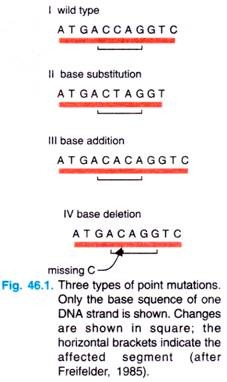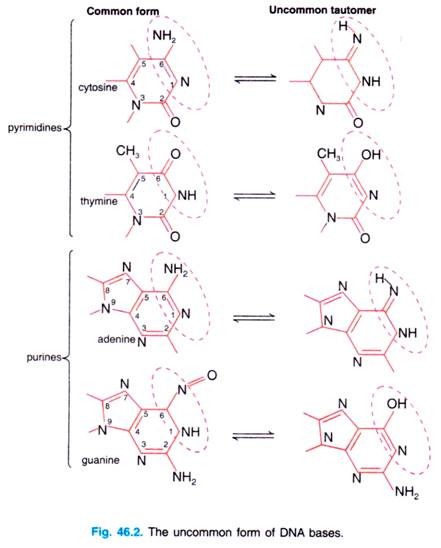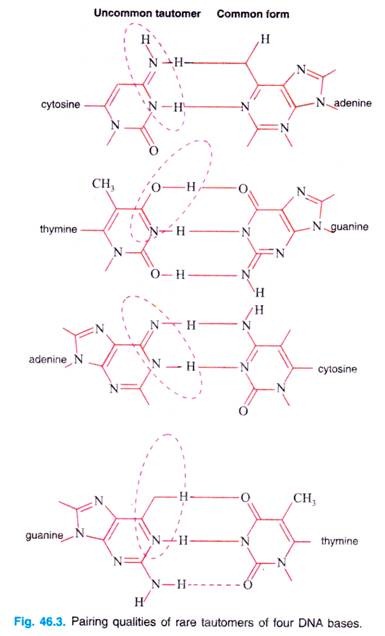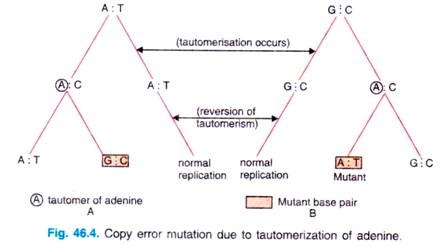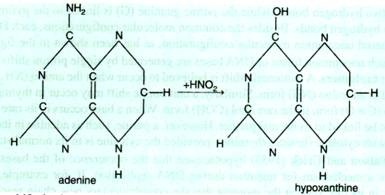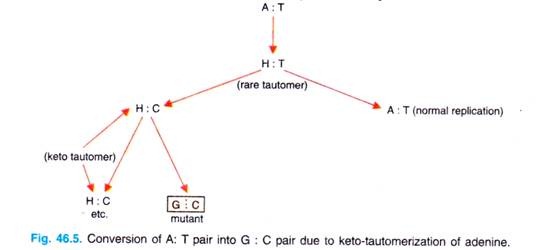Mutations have been classified variously according to different criteria as follows: 1. Classification of Mutation According to Type of Cells 2. Classification of Mutations According to the Size and Quality 3. Classification of Mutation According to the Origin 4. Classification of Mutation According to the Direction 5. Classification of Mutation According to Magnitude of Phenotypic Effect and a few others.
Classification of Gene Mutation
- Essay on the Classification of Mutation according to the Type of Cells
- Essay on the Classification of Mutations according to the Size and Quality
- Essay on the Classification of Mutation according to the Origin
- Essay on the Classification of Mutation according to the Direction
- Essay on the Classification of Mutation according to the Magnitude of Phenotypic Effect
- Essay on the Classification of Mutation according to the Consequent Change in Amino Acid Sequence
- Essay on the Classification of Mutation according to the Types of Chromosomes
Essay # 1. Classification of Mutation according to the Type of Cells:
According to their occurrence in somatic and germinal cells, following types of mutations have been classified:
A. Somatic mutations:
The mutations occurring in non-reproductive body cells are known as somatic mutations. The genetical and evolutionary consequences of somatic mutations are insignificant, since only single cells and their daughter cells are involved.
If, however, a somatic mutation occurs early during embryonic life, the mutant cells may constitute a large proportion of body cells and the animal body may be a mosaic of different types of cells. Somatic mutations have often been related with malignant (cancerous) growth.
Examples of somatic mutation have been reported in Oenothera lamarckiana (by Hugo de Vries) and several other cases including human beings. In human beings, somatic mutation causes several fatal diseases such as paraoxysmal nocturnal haemoglobinura, circumscribed neurofibroma, unilateral retinoblastoma and heterochromia of the iris.
B. Gametic mutations:
The mutations occurring in gamete cells (e.g., sperms and ova) are called gametic mutations. Such mutations are heritable and of great genetical significance. The gametic mutations only form the raw material for the natural selection.
Essay # 2. Classification of Mutations According to the Size and Quality:
According to size, following two types of mutations have been recognised:
A. Point mutation:
When heritable alterations occur in a very small segment of DNA molecule, i.e., a single nucleotide or nucleotide pair, then these types of mutations are called “point mutations”. The point mutations may occur due to following types of sub-nucleotide change in the DNA and RNA.
1. Deletion mutations:
The point mutation which is caused due to loss or deletion of some portion (single nucleotide pair) in a triplet codon of a cistron or gene is called deletion mutation. Deletion mutations have been frequently reported in some bacteriophages (Phage T4).
2. Insertion or addition mutation:
The point mutations which occur due to addition of one or more extra nucleotides to a gene or cistron are called insertion mutations. The insertion mutations can be artificially induced by certain chemical substances called mutagens such as acridine dye and proflavin.
A proflavin molecule, it is believed, insert between two successive bases of a DNA strand, thereby stretching the strand lengthwise. At replication, this situation would allow the insertion of an extra nucleotide in the complementary chain at the position occupied by the proflavin molecule.
The mutations which arise from the insertion or deletion of individual nucleotides and cause the rest of the message downstream of the mutation to be read out of phase, arc called frameshift mutations. They result in the production of an incorrect, hence, inactive protein, due to which death of the cell may occur.
3. Substitution mutation:
A point mutation in which a nucleotide of a triplet is replaced by another nucleotide, is called substitution mutation. The substitution mutation affect only a particular triplet codon. Such an altered code word (triplet codon) may designate a different amino acid and may result in the production of a protein with a single amino acid substitution. The substitution mutations alter the phenotype of an organism variously and are of great genetical significance.
They may be of following types:
(i) Transition:
When a purine (e.g., adenine) base of a triplet codon of a cistron is substituted by another purine base (e.g., guanine) or a pyrimidine (e.g., thymine) is substituted by another pyrimidine base, (e.g., cytosine) then such kind of substitution is called transition. The transitional substitution mutations occur due to tautomerization.
Tautomerization:
In a DNA molecule, normally, the purine, adenine (A) is linked to the pyrimidine, thymine (T), by two hydrogen bonds, while the purine guanine (G) is linked to the pyrimidine, cytosine (C) by three hydrogen bonds. Besides the common molecular configurations, each DNA base may have some altered uncommon molecular configuration, as has been shown in the figure 46.2.
Such uncommon forms of DNA bases are generated by single proton shifts and are called rare states or tautomers. A tautomeric shift is believed to occur when the amino (NH2) form of adenine is changed to an imino (NH) form. Similarly, a tautomeric shift may occur in thymine changing it form the keto (C = O) form to the rare enol (COH) form.
When a base occurs in its rare or tautomeric state, it cannot be linked to its normal partner. However, a purine, such as adenine in its rare state can form a bond with cytosine (besides thymine), provided the cytosine is in its normal state.
Watson and Crick (1953) hypothesised that the occurrence of the bases in their rare states provides a mechanism for mutation during DNA replication. If, for example, adenine in an old chain is in its rare state at the moment that the complementary new chain reaches it, cytosine can pair with it (adenine) and be added to the growing end of the new chain.
The result of this type of pairing is the formation of a DNA molecule that contains an exceptional base pair. This situation is not stable and at the next replication, adenine is expected to return to its common state and to pair with thymine.
Cytosine introduced into the complementary strand due to tautomeric shift in adenine, would then pair with guanine. Thus, there would be formed two kinds of DNA molecules, one that is identical to the original DNA and another that has undergone a base pair substitution of G-C for A-T.
This transitionally substituted DNA molecule has altered coding at a point and results in recognisable mutation. Such mutations which formed during DNA replication are called copy error mutations. Such copy error mutations have been shown by Figure 46.4.
The abnormal pairing due to transitional substitution may also occur due to ionisation of a base at the time of DNA replication. Ionisation involves the loss of the hydrogen from the number one nitrogen of a base. For example, in its ionised state, thymine can pair with guanine, if the guanine is in its common form.
In a similar fashion, guanine in its ionised state can pair with thymine in its common form. From any such unstable base pair, a transition will result following the steps outlined in Fig. 46.4 for A-T to G-C and G-C to A-T.
Effect of Chemical Mutagens on Nucleotide Sequence:
(a) Alteration in Resting Nucleic Acid:
1. Deamination:
Some chemical substance such as nitrous acid causes transitional mutation due to oxidative deamination of DNA bases. In the process of oxidative deamination, the amino group (NH2) of a DNA base is replaced by hydroxyl (OH) group by the chemical mutagen.
Thus, adenine is determinate into hypoxanthine by nitrous acid as shown in the following figure:
By tautomeric shift the hypoxanthine (HX) is converted into more common keto-tautomer which pairs with cytosine. The A: T pair, thus, can be converted to a G: C pair.
Similarly, deamination converts cytosine to uracil, which has pairing properties similar to thymine and in such a case G: C pair would be changed into A: T pair.
2. Hydroxylamine, (HA = NH2.OH) and hydrazine (HZ =NH2NH2):
When DNA is treated with hydroxylamine (HA), its cytosine base is the strongest reacting base. Hydroxylamine probably cause hydroxylation of cytosine at amino group giving rise to hydroxykytosine, which then subsequently pair with adenine. Thus, hydroxylamine (HA) induces in DNA a GC → AT base pair transition (Fig. 46.6).
The hydrazine affects DNA by breaking of rings of uracil and cytosine giving rise to pyrazolone and 3- aminopyrasole, respectively. The treatment of RNA or DNA with anhydrous hydrazine results in the destruction of their pyrimidines.
3. Alkylating agents:
Some alkylating agents carry one, two, or more alkyl groups in a reactive form and act as strong mutagens. Examples of some most extensively studied alkylating agents include diethyl sulphate (DES), dimethylsulphate (DMS), methyl methane sulphonate (MMS), ethyl ethane sulphonate (EES) and ethyl methane sulphonate (EMS).
These mutagens produce mutations in the following ways:
(1) They add ethyl or methyl groups to guanine. This makes guanine the base analogue to
(2) They remove the alkylated guanine. This is known as depurination. The loss of the base produces gaps in the DNA chain which may be filled with a wrong base, thus, producing mutation.
(3) The gap may also produce a deletion, causing mutation.
(b) Alteration during Replication of Nucleic Acid:
1. Base analogues:
Certain chemical substances have molecular structure similar to the usual DNA bases that, if they are available, such analogues may be incorporated into a replicating DNA strand For example, 5-bromouracil (5BU) or its nucleoside 5-bromodeoxyundme (5-BUdR) in its usual (keto) form is a structural analogue of thymine (5-methyluracil) and it will substitute tor thymine.
Thus, an A-T pair becomes and remains A-BU. There is some in vitro evidence to indicate the BU immediately adjacent to an adenine in one of DNA strands causes the latter to pair with guanine. But, in its rare (enol) state, 5BU behaves similar to the tautomer of thymine and pairs with guanine. This converts A: T to G: C as shown in Figure 46.7.
2. Aminopurine (2-AP) is another base analogue which is a relatively undifferentiated purine that apparently can pair with cytosine and thymine. It is thought that 2-AP acts by switching pyrimidines: for example, it may be incorporated opposite thymine during one round of replication and then pair with a cytosine at the next round to produce an AT → GC transition.
2. Inhibition of precursors of nucleic acids:
There are some mutagens which interfere with the synthesis of nitrogen bases of nucleic acids such as purines or pyrimidines. Often lack of one base either causes breaks or causes pairing mistakes.
For example, azaserine (a potent alkylating agent) inhibits purine synthesis and urethane (a mild alkylating agent) is an inhibitor of pyrimidine synthesis However, urethane induced chromosome breaks are inhibited by thymine.
3. Transversion:
The substitution mutation when involves the substitution or replacement of a purine with a pyrimidine or vice versa then that type of substitution mutation is called transversion mutation. The existence of transversion mutation was first of all postulated by E. Freese in 1959.
We still have poor information about the mechanism of induction, identification and characterisation of transversion mutations. Moreover, it is extremely difficult to recognise transversion mutations genetically. However, they can be recognized only by analysis of amino acid substitutions in proteins.
Effects of Physical Conditions on Nucleotide Sequence:
High temperature and low pH value are known to affect depurination or loss of purine bases. The removal of a purine from a strand of DNA leaves a gap at that point. At the time of replication it would be possible for any of the four bases to insert in the complementary newly formed strand. If the inserted nucleotide contained a purine, the complementary strand would contain a transversion.
B. Multiple mutations or gross mutations:
When changes involving more than one nucleotide pair, or entire gene, then such mutations are called gross mutations.
The gross mutations occur due to rearrangements of genes within the genome and may be of the following types:
1. The rearrangement of genes may occur within a gene. Two mutations within the same functional gene can produce different effects depending on gene whether they occur in the cis or Trans position.
2. The rearrangement of gene may occur in number of genes per chromosome. If the number of gene replicas are non-equivalent on the homologous chromosomes, they may cause different types of phenotypic effects over the organisms.
3. Due to movement of a gene locus, new type of phenotypes may be created, especially when the gene is relocated near heterochromatin.
The movement of gene loci may take place due to following method:
(i) Translocation:
Movement of a gene may take place to a non-homologous chromosome and this is known as translocation.
(ii) Inversion:
The movement of a gene within the same chromosome is called inversion.
Essay # 3. Classification of Mutation according to the Origin:
According to the mode of origin, following two kinds of mutations have been recognised:
(1) Spontaneous mutations:
The spontaneous mutations occur suddenly in the nature and their origin is unknown. They are also called “background mutation” and have been reported in many organisms such as, Oenothera, maize, bread molds, microorganisms (bacteria and viruses), Drosophila, mice, human beings, etc.
(2) Induced mutations:
Besides naturally occurring spontaneous mutations, the mutations can be induced artificially in the living organisms by exposing them to abnormal environment such as radiation, certain physical conditions (i.e., temperature) and chemicals. The substances or agents which induce artificial mutations are called mutagens or mutagenic agents.
Mutagenic agents:
The mutagenic agents are of the following kinds:
A. Radiations:
The radiations which are important in mutagenesis are of two categories: one type is ionising radiations such is X-rays and gamma rays; alpha and beta rays; electrons, neutrons, protons and other fast moving particles. The second type is non-ionising radiations such as ultraviolet and visible light.
Both types of radiations induce mutations by following methods:
(i) Ionising radiations as mutagens:
Relatively little is known about the mechanism by which ionising radiations cause mutation. As, we are already familiar that matter composed of atoms and atoms, in turn, are made up of a positively charged atomic nucleus (with neutrons, protons) and a surrounding cons-tellation of negatively charged electrons.
The charges of atomic particles remain so balanced that normal atoms are electrically neutral. When ionising radiations pass through matter, they dissipate their energy in part through the ejection of electrons from the outer shell of atoms and the loss of these balancing, negatively-charged particles (electrons) leaves atoms which are no longer neutral but are positively charged.
The positively-charged atom is called ion. The ejected electrons move at high speed; knock other electrons free from their respective atoms and when their energy is dissipated, become attach to other atoms and convert the atoms into negatively charged ions.
To achieve their stable configuration (i.e., neutral charge), ions undergo many chemical reactions and during these chemical reactions ionising radiation is thought to cause mutation.
Further, ionizing radiations cause breaks in poly-sugar phosphate backbone of DNA and, thus, causing chromosomal mutations such as break, deletion, addition, inversion and translocation.
During breakage of DNA molecule due to ionising radiation, the active role of oxygen is predicted. Because, oxygen is important in the formation of H2O2 and H2O in irradiated water and these products may induce breaks in DNA molecule.
(ii) Non-ionising radiations as mutagens:
The ultraviolet (UV) light is a non-ionizing radiation which may cause mutation. The most effective wavelength of ultraviolet for inducing mutations is about 2,600 A°. This is a wavelength that is best absorbed by DNA and a wavelength at which proteins absorb little energy.
When a substance absorbs sufficient energy from the ultraviolet light, some of their electrons are raised to higher energy levels, a state called excitation. The excited molecule becomes reactive and mutated and is called photoproduct.
Dimerization:
The ultraviolet radiation produces several effects on DNA, one being the formation of chemical bonds between two adjacent pyrimidine molecules in a polynucleotide and particularly, between adjacent thymine residues as shown in Fig. 46.9.
As the two thymine residues associate, or dimerize to form a dimer, their position in the DNA helix becomes so displaced that they can no longer form hydrogen bonds with the opposing purines and thus regularity of the helix becomes distorted. Thus, dimerization interferes with the proper base pairing of thymine with adenine, and result in thymine’s pairing with guanine. This will produce a T-A to C-G transition.
B. Temperature as mutagen:
The rate of all chemical reactions are influenced by temperature. It is not surprising that temperature can be mutagenic. It is reported that the rate of mutation is increased due to increase in temperature.
For example, an increase of 10°C temperature increases the mutation rate two or three-fold. Temperature probably affects both thermal stability of DNA and the rate of reaction of other substances with DNA.
A study of Swedish nudist indicated that the scrotal temperature of human males in ordinary clothing is about 3°C higher than that of nude male. The higher temperature could well increase the mutation rate nearly two-fold, leading the investigators to suggest that the wearing of pants has possibly been much more unhygienic than fallout from testing of nuclear devices threatens to be. They suggested the wearing of kilts as one solution.
C. Chemical mutagens:
Many chemical substances have been responsible to increase the mutability of genes. The ability of chemicals to induce mutation was first of all demonstrated by Auerbach and Robson in 1947 using mustard gas, and related compounds as the nitrogen and sulphur mustards, mustard oil and chloracetone in experiments with male Drosophila melanogaster.
Since then many chemical compounds which are ordinarily considered to be non-toxic have been found to be mutagenic in certain specific situations. Any chemical substance that affects the chemical environment of chromosomes is likely to influence, at least indirectly, the stability of DNA and its ability to replicate without error. A chemical mutagen can cause mutation only when it enters in the nucleus of the cell.
It can affect the chromosomal DNA by following two ways:
(1) Direct gene change:
Certain chemical mutagens affect DNA directly. They affect the constituents of DNA only when DNA is not replicating. For example, nitrous acid converts adenine into hypoxanthine and cytosine to uracil by deamination.
Like the nitrous acid, nitrogen mustard, formaldehyde, epoxides, dimethyl and diethyl sulphonate, methyl and ethyl methanesulphonate (MMS and EMS) and nitrosoguanidine (NG) also have direct mutagenic effect on the DNA molecule.
(2) Copy error:
Certain chemical compounds, called base analogues {e.g., 5-bromouracil, 2- aminopurine, etc.) closely resemble with certain DNA bases and therefore, act as mutagens. During DNA replication, they are incorporated by DNA in place of the normal DNA bases.
Certain other base analogues such as urethane triazine, caffeine (in coffee, tea and soft drinks), phenol and carcinogens, acridines (proflavin, etc.), have mutagenic effects. Certain inorganic substances such as manganese chloride is mutagenic for many organisms, as, they are the compounds which bind calcium and, thus, interfere with the integrity of the chromosome structure.
Essay # 4. Classification of Mutation According to the Direction:
According to their mode of direction, following types of mutations have been recognised:
(A) Forward mutations:
In an organism when mutations create a change from wild-type to abnormal phenotype, then that type of mutations are known as forward mutations. Most mutations are forward type.
(B) Reverse or back mutations:
The forward mutations are often corrected by error correcting mechanism so that an abnormal phenotype changes into wild-type phenotype.
They may be of the following types:
(i) Single site mutations:
Some reverse mutations change only one nucleotide in the gene and are called single site mutations.
For example, due to forward mutation the adenine is changed into guanine and backward mutation change guanine into adenine:
(ii) Mutation suppressor:
When a mutation occurs at a different site from the site where already primary mutation occurred and that mutated gene reverse the effects of primarily mutated gene, then such (secondary) mutations are called mutation suppressors.
They may be of following types:
(а) Extragenic suppressor:
The extragenic suppressor mutation occurs in a different gene from that of the mutant gene. In E. coli, a gene mutation suppressor gene called rec A (rec for recombination) is known which is necessary for recombination and is found to repair ultraviolet- induced thymine dimers of a gene by a process called postreplication recombinational repair.
(b) Intragenic suppressor:
The intragenic suppressor mutation occurs in a different nucleotide within the same gene and shift the reading frame back into register.
(c) Photoreactivation:
In photoreactivation type reverse mutation, reversal of ultraviolet induced thymine dimers takes place by specific enzymes in the presence of visible light waves. During ultraviolet radiation, a particular enzyme is selectively bound to the bacterial DNA. During photoreactivation the enzyme is activated by visible light and that cleaves the pyrimidine or purine dimers into monomers and restores their original forms.
(d) Excision repair or Dark reactivation:
In an ultraviolet (UV) induced mutation, the reverse mutation may also occur in the absence of light.
According to Howard Flanders and Boyce (1964), dark reactivation includes following stages:
(i) An enzyme possibly endonuclease makes a cut in the polynucleotide strand on either side of the dimer which may be formed due to ultraviolet radiation and excises a short, single-strand segment of the DNA.
(ii) Another enzyme, possibly exonuclease widens the gap produced by the action of the endonuclease.
(iii) DNA polymerase resynthesises the missing segment, using the remaining opposite strand as a template; and
(iv) the final gap is closed by some enzymatic rejoining process, (i.e., DNA ligase).
Essay # 5. Classification of Mutation According to Magnitude of Phenotypic Effect:
According to their phenotypic effects following kinds of mutations may occur:
1. Dominant mutations:
The mutations which have dominant phenotypic expression are called dominant mutations. For example, in human beings the mutation disease aniridia (absence of iris of eyes) occurs due to a dominant mutant gene.
2. Recessive mutations:
Most types of mutations are recessive in nature and so they are not expressed phenotypically immediately. The phenotypic effects of mutations of a recessive gene is seen only after one or more generations, when the mutant gene is able to recombine with another similar recessive gene.
3. Isoalleles:
Some mutations alter the phenotype of an organism so slightly that they can be detected only by special techniques. Mutant genes that give slightly modified phenotypes are called isoalleles. They produce identical phenotypes in homozygous or heterozygous combinations.
4. Lethal mutations:
According to their effects on the phenotype, mutations may be classified as lethals, subvitals and supervitals. Lethal mutations result in the death of the cells or organisms in which they occur.
Subvital mutations reduces the chances of survival of the organism in which they occur. Supervital mutations, in contrast, cause the improvement of biological fitness under certain conditions:
Essay # 6. Classification of Mutation According to Consequent Change in Amino Acid Sequence:
1. Missense mutations:
They change the meaning of a codon, changing one amino acid into another.
2. Temperature sensitive mutations or Ts mutations:
If the substitution produces a protein that is active at one temperature (typically 30°C) and inactive at a higher temperature (usually 40 – 42°C).
3. Nonsense or chain termination mutations:
They arise when a codon for an amino acid is mutated into a termination codon (UAG, UAA or UGA), resulting in the production of a shorter protein.
Since, temperature-sensitive and chain termination mutations exhibit the mutant phenotype only under certain conditions, they are called conditional mutations; they are the most versatile and useful mutations.
4. Silent mutations:
They change a nucleotide but not the amino acid sequence because they affect the third position of the codon, which is usually less important in coding. This is a silent mutation because it leaves the protein sequence unchanged.
Essay # 7. Classification of Mutation According to the Types of Chromosomes:
According to the types of chromosomes, the mutations may be of following two kinds:
1. Autosomal mutations:
This type of mutation occurs in autosomal chromosomes.
2. Sex chromosomal mutations:
This type of mutation occurs in sex chromosomes.
